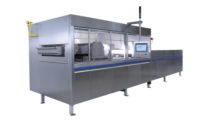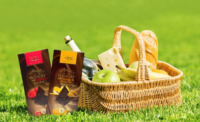Mention the word Haas to anyone familiar with the baking, snack or confectionery industries, and the word wafer automatically comes to mind. In fact, an image of a narrow, rectangular-sized filled wafer probably accompanies the word association.
But since 1905, when Josef Haas established a building and machine fitting business in Vienna, to its evolution as Franz Haas Waffelmaschinen (FHW) in 1966, and finally to its current structure as the Haas Group consisting of four subsidiaries (FHW, Franz Haas CFT, Haas-Mondomix and Haas-Meincke), the company has evolved to meet the changing dynamics of the marketplace as well as consumer lifestyles.
Today’s fourth generation co-owners, Stefan Jiraschek, Johannes Haas and Josef Haas, oversee a diversified operation that dovetails a tradition of impeccable engineering standards and equipment performance with a customer-centric service philosophy.
As Josef Haas explains, “Today, you have to listen and understand what people are looking for. It’s not just technological competence regarding the equipment, but it involves what kind of products that equipment is producing.”
To that end, the Haas Group has invested heavily in research and development; not only in structures, such as the new 1,300 sq.-meter (14,000 sq. ft.) Haas-Meincke Tech Center in Copenhagen christened last year, but in talent as well, employing scores of food technologists dedicated to product development.
Consider the company’s latest equipment entry, the center-filled cake line, which can be seen at the company’s Leobendorf headquarters and production facility in Austria. As Michael Baumann, managing director of Haas CFT (Convenience Food Equipment) explains, the product concept originated in Japan.
The center-filled cakes are made from fluffy sponge cake batter and come in special shapes, such as animals and/or apples and are filled with fruit, chocolate or vanilla fillings. As one can imagine, such treats have proven extremely popular with children.
Two years in development, the center-filled cake line represents the first such automated production unit in the marketplace. It’s capable of producing 20,000 pieces per hour, each piece weighing up to 45 grams. The cakes can come in one or two colors and are capable of having one or two fillings.
The moulds, which are produced by Haas, offer a broad range of design capabilities, ranging from everyday concepts (animals and/or fruits) to seasonal or specific promotional campaigns (Santas, bunnies, figures).
The compact unit features a front oven section that automatically deposits batter on heated baking plate pairs, which are mounted on a baking tong chain. After a certain processing time, the baking plates close and move through the oven. When a full turn is completed, the baking plates open again at the oven front section.
A take-off drum gently releases the center-filled cakes from the baking plates and transfers the products to an overhead conveyor. An optional automatic cleaning device that uses cold jet blasting with dry ice pellets can clean the 74 baking plates in less than two hours.
But it’s not just about inventing new product concepts at Haas. It’s also about enhancing existing, traditional items — be they wafers, confections with wafer components or savory treats.
The 500-sq.-meter (5,381 sq. ft.) Tech Center in Leobendorf houses a baking oven for wafer sticks and a flat wafer line as well as related mixing machines. For baking trials, there are manually operated baking devices for flat and hollow wafers as well as a fully automatic baking tong. With the MINIMONDO, a dedicated device is provided for test applications regarding the aeration of creams.
One of the latest twists to traditional wafer products has come in the form of shapes. The free-shape cutter FF-AWDM, which was shown in operation at the ProSweets show held earlier this year in Cologne, allows manufacturers to produce wafers in various shapes.
“In confectionery, perception is often created by packaging, be it fancy or simply colorful,” says Andreas Clemenz, head of technology & applications development, FHW. “Shapes can do that as well. With the free-shape cutter, you can cut whatever kind of shapes you want, be it for a limited edition or seasonal product. And you can do so without any changeovers.”
To get the perfect shape, two cutters are consecutively linked with each other. The first one cuts the outlines or the first half of the figure. Then, the pre-cut wafers are fed “short side leading” into the second cutter.
What’s critical to the process is the handling of the wafer books. These are fixed when fed into the second cutter, which cuts them to their final shape by a controlled x/y movement. The free-shape cutter manages up to 10 cutting cycles per minute.
The high cutting speed of the FF-AWD produces clean surfaces and prevents sticking of product on the wires as well as breaking of the wafers. The finished wafer figures may be either fed to packaging or dipped in chocolate for bottom coating.
As Clemenz notes, “The marketing people’s eyes just lit up when they visited our booth at ProSweets.”
That’s clearly the role of Haas Group’s Tech Centers, illuminating potential market opportunities as a means of helping manufacturers take advantage of global and local trends. Another example involves gluten-free and protein snacks, which continue to gain traction across markets throughout the world. As does a movement toward using ingredients grown locally. In some cases, several trends can be tapped into simultaneously.
For example, wafers needn’t be produced from wheat flour. Rather, blue, yellow or red potatoes or black rice or red corn are only some possibilities. Existing natural colors in these ingredients eliminate the need for artificial ones and can help create “better-for-you“ products. There’s also buckwheat, which is gluten-free and can be used to create alternative snack products.
“At the moment we’re running tests with different local ingredients in our worldwide Tech Centers,” adds Clemenz. “The gained experiences over all Haas companies and also over all continents run into our new recipes and product developments. We can offer our customers already a large portfolio of recipes, and we will, of course, assist our customers in their individual recipe developments.”
Thus, it’s not surprising to see a technician at the Tech Center producing hollow wafers made from chickpea flour for use in a savory snack test.The product delivers a protein punch.
But there’s more to the Haas Group than having talented food technologists trailblazing product development. There’s also an incredibly long history of engineering expertise as well as personalized customer service.
“I remember when I was a toddler during the time my father brought home 10 Arabic customers for dinner, not telling my mother a word in advance about the guests,” says Josef. “Bringing people home to break bread together was part of the culture. Yes, it’s about figures and performance, but it’s also about relationships.”
As a result, the co-owners are often on the road. Josef, who heads up sales, spends his time visiting customers.
“It’s all about keeping our promises,” he says.
Thus, a sale doesn’t end with a signed contract. It continues through the assembly process, factory inspection, delivery, acceptance and onto the very life of the machine, which can reach 50 years or more.
“In the 1970s and 1980s, there was a different timeline,” Josef continues. “Today, time to market is really critical. Customers expect a certain level of instant perfection. Back then, one had a few weeks to install a machine. Again, today, that’s not the case. Product life cycles are shorter. It’s critical for customers to get their products to the shelves as quickly as possible. As a premium machine supplier, we’re obliged to give them the best return on investment.”
And that often starts with assembly. Günther Muhr, FHW’s general manager, can attest to the pressures of meeting delivery times.
In the past, it would vary from seven to nine months, he says. Currently, Muhr’s group has reduced the lead time to between six to seven months. The goal now is below six months, he says, but the executive believes that the lead time can go down to five months within two years.
Part of Muhr’s optimism stems from the company’s flexibility in manufacturing. After all, FHW manufactures nearly all of its equipment parts on-site. Although it might be less expensive at times to have sub-contractors provide such items, the ability to do so has proven invaluable to the manufacturing unit, even more so to many customers.
There are plenty of examples whereby customers operating wafer machines 50 years or older called the company, pleading for a specific component. By referring back to original blueprints, the company could reproduce the component on-site — and in a few days.
Muhr also cites “Industrie 4.0” — a high-tech strategy introduced by the German government to promote the computerization of manufacturing — as a tool to improve operating efficiencies.
Dubbed the “Fourth Industrial Revolution,” the process aims to not only ratchet up manufacturing efficiencies, but incorporate information technology to interconnect data systems (also referred to as cyberphysical systems) with one another using standard Internet-based protocols. This improves the systems’ ability to analyze data, which improves manufacturing forecasting, everything from predicting failures to reconfiguring processes and adapting to changes.
This interconnectivity, however, isn’t merely amongst machines; it also involves engaging specialists from all branches of the company, including R&D, in the manufacturing process.
Muhr cites the example of work on a new wafer oven that was being developed by Haas several years ago.
“By replacing the nozzles, we essentially created a new heating system and a new oven, reducing gas consumption by 20 percent,” he says.
The interconnectivity extends beyond manufacturing of equipment; it continues through and after the installation of machines. As a result, the company continues to monitor a machine’s performance at the customer’s location.
“We’re invested in taking care of the efficiency of the line,” Josef points out. “So, we conduct line audits, efficiency audits to determine productivity and efficiency. It’s really part of the company’s DNA, ensuring customer satisfaction.”
And, today, it’s also about customer inspiration, be it a wafer shaped in a star, an aerated cream filling or a center-filled cake shaped like a bear.
“We look to inspire customers with new ideas so that they can benefit from our worldwide activities,” he adds. “By offering that service, we can inspire and develop solutions for them.”
See also: Dining by the Danube: One on One with Josef Haas
At-a-glance: Haas Group
Headquarters: Leobendorf, Austria
Subsidiaries: Franz Haas Wafflemaschinen, Franz Haas CFT, Haas-Mondomix and Haas-Meincke
Employees (2014): 1,600
Sales (2014): €278 million
Projects: About 450 annually
Affiliates, Sales and Service Offices: Brazil, China, United States, Singapore, India, Russia, Colombia, Ghana, Turkey and U.A.E.



















